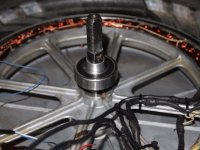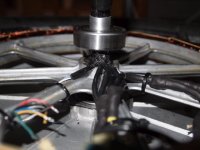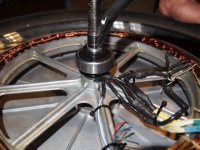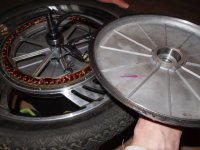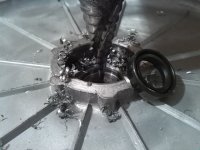Somebody should make a parasitically powered Bluetooth temperature transmitter. It could be powered by the 5v hall line or directly from phase wires with the right regulator circuit.
You are using an out of date browser. It may not display this or other websites correctly.
You should upgrade or use an alternative browser.
You should upgrade or use an alternative browser.
Leaf / leafmotor / leafbike high efficiency 1500w motor
- Thread starter neptronix
- Start date
crossbreak
1 MW
sadly, getting a bluetooth signal through a perfect faraday cage like a hub housing wont be so easy 
crossbreak
1 MW
oh i forgot...he will vent it... if his vent holes are larger than Lambda/4 of the bluettoth wavelength.. it should indeed be possible. That would be 11mm for 2.4Ghz if i calced right
anyway i'm against it.. drilling holes into a hub housing for venting lacks of sanity. Oil cooling works too good even on geared hubs, which are a lot more difficult to cool with oil since they run faster. Just do a great sealing job. Engine seal is cheap. Seal rings too
Adding two tiny wires for thermistor should not be too hard if the wires are swapped anyway...best would be if we could buy this one with 10k thremistor built in and wired up. Just like the MAC from cellman
anyway i'm against it.. drilling holes into a hub housing for venting lacks of sanity. Oil cooling works too good even on geared hubs, which are a lot more difficult to cool with oil since they run faster. Just do a great sealing job. Engine seal is cheap. Seal rings too
Adding two tiny wires for thermistor should not be too hard if the wires are swapped anyway...best would be if we could buy this one with 10k thremistor built in and wired up. Just like the MAC from cellman
teslanv said:Nep,
Per previous notes you have the Kv at 13.16 ...
For what its worth, I have one of these 1500w motors in my test stand here, and have just measured the Kv at 12.92 -using an optical tacho.
(no field weakening or "120%" speed setting tricks)
For comparison with a couple of others highish Kv hubs :
Leaf Bike 1500w standard = 12.92 Kv
Mac 6t = 12.36 Kv
MXUS 45mm 3t = 11.72 Kv
Burtie
This is why i love you guys - dreaming up these kinds of things and figuring out how they work. A bluetooth temp sensor would be fantastic... IF the signal could escape a few thousand watts of whatever crazy kind of electro-magnetic fields that happen inside a hub motor 
But now, i can get an accurate vision of the temperature by simply pointing a temp sensor at the coils through a hole.. :lol:
For the record, i don't like vented hub motors in the slightest. I don't like oil cooled motors that tend to leak all over the damn place either. Both have their disadvantages. This motor doesn't have the tightest sealing, so i figured that it was not a candidate for oil cooling; i have taken it apart and put it together enough times to scratch up the axle-bearing contact surface anyway. The truth is that i need this motor to do up to 45mph for my transportation needs. If the motor gets trashed by venting, that is okay. I will simply purchase a MXUS 3kW motor because it is more in-line with the power capability that i need, possibly, taking an overall efficiency hit at slow speeds in the process, but gaining a lot of efficiency at high speeds.
I definitely prefer this motor over an mxus 3kw for now though. When you spin the motor by hand, you cannot feel any cogging. I can pedal the thing up to 20mph. It's wonderful.
If i had routes into town where 35-40mph was the speed limit, i'd have no issue keeping the motor unvented indefinitely. Where is live is basically a high speed rollercoaster though, with some sections where i am making a 1% constant grade in stop and go traffic. That's a real demanding task for any motor.
I'm determined to show you guys what the motor can do when fully saturated though.
I will have some vented, saturated results sometime this weekend.
But now, i can get an accurate vision of the temperature by simply pointing a temp sensor at the coils through a hole.. :lol:
For the record, i don't like vented hub motors in the slightest. I don't like oil cooled motors that tend to leak all over the damn place either. Both have their disadvantages. This motor doesn't have the tightest sealing, so i figured that it was not a candidate for oil cooling; i have taken it apart and put it together enough times to scratch up the axle-bearing contact surface anyway. The truth is that i need this motor to do up to 45mph for my transportation needs. If the motor gets trashed by venting, that is okay. I will simply purchase a MXUS 3kW motor because it is more in-line with the power capability that i need, possibly, taking an overall efficiency hit at slow speeds in the process, but gaining a lot of efficiency at high speeds.
I definitely prefer this motor over an mxus 3kw for now though. When you spin the motor by hand, you cannot feel any cogging. I can pedal the thing up to 20mph. It's wonderful.
If i had routes into town where 35-40mph was the speed limit, i'd have no issue keeping the motor unvented indefinitely. Where is live is basically a high speed rollercoaster though, with some sections where i am making a 1% constant grade in stop and go traffic. That's a real demanding task for any motor.
I'm determined to show you guys what the motor can do when fully saturated though.
I will have some vented, saturated results sometime this weekend.
teslanv
1 MW
neptronix said:I definitely prefer this motor over an mxus 3kw for now though.
Have you ran a MXUS 3000W Motor?
No, i have not. But i've exhaustively read everything about it i can find.
This is a dual suspension bike, and unsprung weight matters. I wanted the lightest X most capable motor i could get. When i uninstalled the bafang mid drive and put a hub motor in, i took a major hit to my handling. The bike used to float along everything. So i'm pretty reserved when it comes to getting a heavier motor.
This is a dual suspension bike, and unsprung weight matters. I wanted the lightest X most capable motor i could get. When i uninstalled the bafang mid drive and put a hub motor in, i took a major hit to my handling. The bike used to float along everything. So i'm pretty reserved when it comes to getting a heavier motor.
teslanv
1 MW
Some weight comparisons:
Manufacturer's Spec weight on the leaf Motor is 7.18 Kg.
Measured weight on the MXUS motors is 9.14 Kg, for a difference of 1.96 Kg or 4.3 lbs.
Let me know if you want to try one Nep.
Manufacturer's Spec weight on the leaf Motor is 7.18 Kg.
Measured weight on the MXUS motors is 9.14 Kg, for a difference of 1.96 Kg or 4.3 lbs.
Let me know if you want to try one Nep.
When you spin the motor by hand, you cannot feel any cogging
Does anyone have any idea how they accomplished this voodoo? I remember Justin added a noticeable space between each magnet, which slightly lowered power, but also raise efficiency and removed almost all the cogging.
I recall a pic posted earlier here and there was one small gap shown, but...the rest of the magnets seemed to be shoulder-to-shoulder?...
Laminations and tight coils.. i dunno. I'll do a spindown video in a moment.
Anyway, i did a 72v run again. It does 60mph. Video is on my YT channel, but will not be posted here.
Motor didn't melt.. even though i did a long 3% uphill grade at 50mph after a few 6000W runs up and down a slight grade.. effing amazing. I think that the venting helped a ton.
Anyway, i did a 72v run again. It does 60mph. Video is on my YT channel, but will not be posted here.
Motor didn't melt.. even though i did a long 3% uphill grade at 50mph after a few 6000W runs up and down a slight grade.. effing amazing. I think that the venting helped a ton.
dmwahl
10 kW
Do you happen to have a copy of the 1500W performance curve saved somewhere? It seems that they've replaced it with a 1000W curve and since your first post linked to the image on the leafbikes site it was updated too.
dmwahl
10 kW
Got it, my work firewall was blocking neptronix.org. Thanks.
dmwahl
10 kW
What type of freewheel are you using and did you need any axle spacers?
crossbreak
1 MW
some shots of a seal job on a magic pie2. it has a milled channel in the axis to take the phase wires...just like the leaf motor if i'm right? I really dont want to spam this thread with posting so many pics, but wonder if the same could be done on this leaf motor
pic1 -add a short pipe to the axis above the bearing to slip in the shaft seal. The pipe is 15x17x10 to fit the 15mm OD of the shaft and 17mm ID of the shaft seal
pic2- seal the wire exit with engine sealant (there MUST be something better than engine sealant for this job..really...maybe thin 2k silicone or some Loctite product)
pic3 - get on the shaft seal...that could have been done BEFORE pushing through the AWG11 phase wires...just along with the pipe...oops it was late that night
it was late that night
pic4 seal the side cover with engine sealant
pic5 would be to add 200ml of very thin Insulating oil (i use Total Isovoltine2 since it is a bit cheaper than Shell Diala S2)
pic1 -add a short pipe to the axis above the bearing to slip in the shaft seal. The pipe is 15x17x10 to fit the 15mm OD of the shaft and 17mm ID of the shaft seal
pic2- seal the wire exit with engine sealant (there MUST be something better than engine sealant for this job..really...maybe thin 2k silicone or some Loctite product)
pic3 - get on the shaft seal...that could have been done BEFORE pushing through the AWG11 phase wires...just along with the pipe...oops
pic4 seal the side cover with engine sealant
pic5 would be to add 200ml of very thin Insulating oil (i use Total Isovoltine2 since it is a bit cheaper than Shell Diala S2)
Attachments
crossbreak
1 MW
forgot the pic about subland twist drilling the side cover to make it take the shaft seal (drill it to 26mm). I use a 17x26x7 seal. the same cellman uses for the MAC motor. And the same that the MagicPie2 comes in stock on the sprocket side (i guess)
I did this on a mill, to get this hole well centered. But guess it could be done on a drill press as well, since the subland twist drill centers itself well
I did this on a mill, to get this hole well centered. But guess it could be done on a drill press as well, since the subland twist drill centers itself well
Attachments
Here's the raw dyno data from the first post run against a couple of standard Load Line plots identical to those used in the ebikes.ca simulator. The motor data shown here is the identical data from the original dyno plots - just plotted vs speed instead of torque to yield a more familiar 'justin simulator' presentation. A 'waste heat' plot is added (simply Pin-Pout).neptronix said:Remember that i am running 120% mode on my controller to get that top speed. On 100%, the flat speed is more like 38-39.
The Load Lines assume a mtn bike profile identical to to the ebikes.ca simulator with a 26in wheel and 235lb load (180lb rider, 55lb bike).
Two runs, the first on the flat, the second on a 7% grade.
The top speed for the 'on-the-flat' run corresponds pretty well with nep's report of 38-39mph for a '100% speed' controller configuration.
View attachment 1
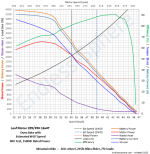
Since these use raw dyno data with a big moose controller, there is no controller limiting apparent in the plots - the leftmost portions of the curves do not roll downward to zero as in the simulator plots.
EDIT - reformatted/replotted w/larger plot area, winding/voltage info, rated power
cycborg
1 kW
Nice. Did you just do an eyeball tabulation of the dyno data, or did you do some curve fitting? Could you please do this for every other dyno plot anyone has posted on ES? :lol:
So 600 W of heat on the 7% grade. Roughly the low setting on a space heater, albeit a space heater enclosed in a metal case. Helps one appreciate the value of venting.
So 600 W of heat on the 7% grade. Roughly the low setting on a space heater, albeit a space heater enclosed in a metal case. Helps one appreciate the value of venting.
Automagic OCR translation of dyno tabular data from jpg in original post into csv file - replotted in Excel.
Easy-peasy.
Thought a familiar standard analysis would be a good verification of nep's results -- even if using a generic weight/bike profile for the Load Line.
Easy-peasy.
Thought a familiar standard analysis would be a good verification of nep's results -- even if using a generic weight/bike profile for the Load Line.
speedmd
10 MW
Looks like this motor would benefit from a slightly smaller wheel /FOC. Impressive performance.
As always - sort of depends on what you are going after. In this example from a top speed perspective a smaller wheel appears slightly counterproductive, although it would certainly add some acceleration at the low end. By the estimate below for a 24 in wheel, it didn't help WOT speed even on a 7% grade...speedmd said:Looks like this motor would benefit from a slightly smaller wheel /FOC.
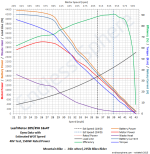
Nep reports the motor responds very well to the Xie Chang controller overspeed settings (eg 120%) which reshape the waveform (increasingly squares up the trap waveform over 100% PWM). It would indeed be interesting to see if a controller with FOC does better.
- BTW - For those who unfamiliar with the technique used in the ebikes.ca simulator (and here) for speed estimates: The Load line (black) shows the power required to propel the bike at various speeds. The estimated speed is where the power required to propel the bike equals the available delivered motor power (red line). This equality is at the intersection of the red and black lines. Since the motor power data came directly off the dyno without simulation or manipulation and the Load Line relies on some fundamental physics drag/power equations (same as in all bicycle power/speed calculators), the results are pretty accurate for the given vehicle profile of aero drag/rolling resistance/weight/wheel size. The 2WD estimate assumes equal tire sizes and is the speed at which the power to propel the bike equals twice the delivered power of a single motor.
speedmd
10 MW
It does look to reduce the waste heat significantly on the flats. Down to aprox. 200W from 300W. Battery power looks to be a big difference also. Interesting trade off. Agree, FOC and possibly higher voltages would be a great comparison.
Hmmm - missed that - thanks for pointing that out. Although that is for 'achievable' top speed not 'equal' speed. To get a true 'speed-based' comparison, we would need to throttle back the 26" wheel case to less than WOT to reduce the speed to the 24" wheel case - a little beyond the scope of these simple no-calculation plots...speedmd said:It does look to reduce the waste heat significantly on the flats. Down to aprox. 200W from 300W. Battery power looks to be a big difference also. Interesting trade off.
Still - a valid observation for the expected WOT driving style. Quite right - it is an interesting tradeoff...
Just got back from a 1 week vacation... glad to see that this thread has evolved into something scientific rather than 'huh, what's leaf motor?' 
Thanks teklektik & others
Yeah, the motor is super happy to run on 120%.. i run it on 120% approximately half the time, to hit ~45mph speeds on 12S Lipo / 75A. When turning on 120%, i feel a torque bump that pushes the motor to 45mph at a pretty quick rate. It's kinda like kicking in VTEC on a Honda..
The only thing to be conscious of is that doing this for extended periods of time up hills/grades can accumulate seriously critical heat levels, even while vented. The motor can maintain 45mph for long periods of time... but do it for 15 miles up constant 0-3% grades ( my commute back home ) and, well, you're gonna be ready to cook breakfast on the motor.. :lol:
So basically, get a temp sensor if you're gonna push the motor beyond 40 constant.. i don't have a temp sensor, so i am basically riding on the edge of overheating the motor in my riding conditions here ( lots of stop and go, lots of hills, 185lb rider, vented motor, 26 inch wheel )
Thanks teklektik & others
Yeah, the motor is super happy to run on 120%.. i run it on 120% approximately half the time, to hit ~45mph speeds on 12S Lipo / 75A. When turning on 120%, i feel a torque bump that pushes the motor to 45mph at a pretty quick rate. It's kinda like kicking in VTEC on a Honda..
The only thing to be conscious of is that doing this for extended periods of time up hills/grades can accumulate seriously critical heat levels, even while vented. The motor can maintain 45mph for long periods of time... but do it for 15 miles up constant 0-3% grades ( my commute back home ) and, well, you're gonna be ready to cook breakfast on the motor.. :lol:
So basically, get a temp sensor if you're gonna push the motor beyond 40 constant.. i don't have a temp sensor, so i am basically riding on the edge of overheating the motor in my riding conditions here ( lots of stop and go, lots of hills, 185lb rider, vented motor, 26 inch wheel )
Similar threads
- Replies
- 0
- Views
- 123
- Replies
- 8
- Views
- 916
- Replies
- 2
- Views
- 818


